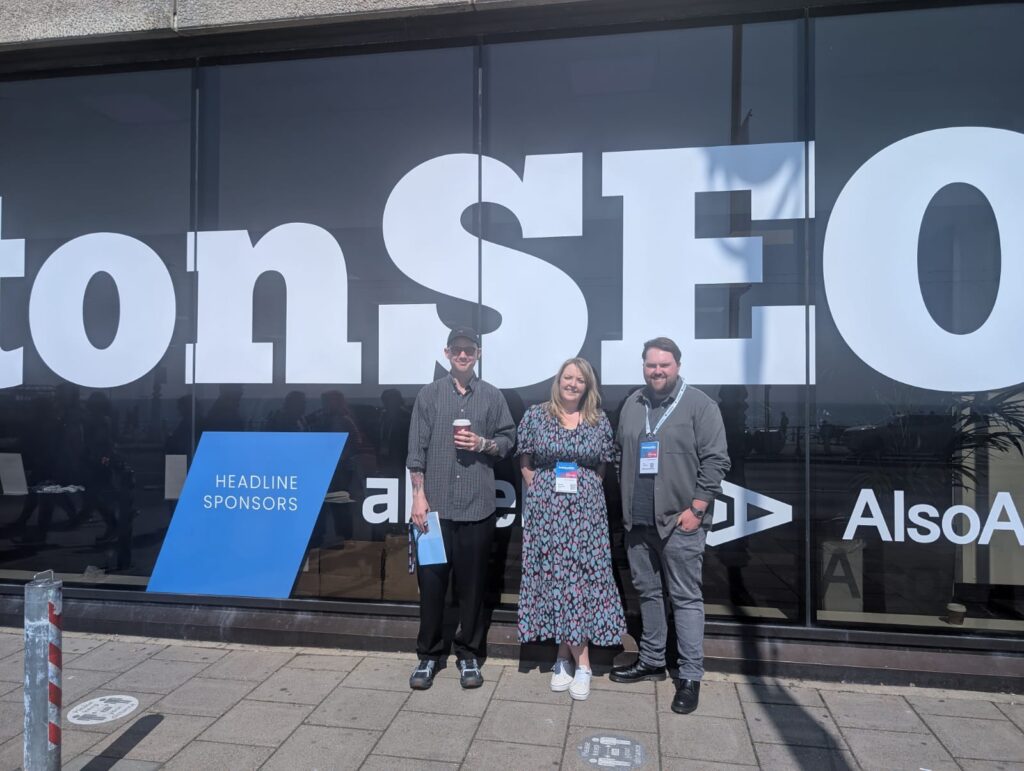BrightonSEO 2025 recap: 5 proven SEO strategies amid AI uncertainty

By Oliver Wells, SEO Director in Digital
“SEO is dead”…
“SEO will never die”…
“SEO is broken and everyone is scared”…
“SEO is better than it ever was”…
I heard a lot of these sorts of statements verbatim and in essence at BrightonSEO 2025, with variations in intensity and conviction. AI is changing the game, and the discipline known as SEO is evolving and at a (potentially) alarming rate. However, nobody knows exactly how AI will ultimately alter the search landscape. AI overviews have added a new dimension to the board but at present the chess pieces remain the same, albeit with a little less success to go around. As an SEO director with over 9 years experience in the field, I was surprised by the contradictions and differences in opinions at play across the two days of talks. From blatant black hat tactics on how to fake EEAT, fear-mongering and tool-pushing, it seems to me that uncertainty and change are the only current constant, with contradictions to be found across agencies, thought leaders and data sets.
With all of this in mind, I wanted to provide you with my top 5 strategies that are proven to work, and will still continue to work for your business, regardless of the changes that AI will bring to the world of search. The focus of each is firmly on your customer base – your users are the beating heart of your revenue stream, the foundation upon which you grow. If you follow these 5 tactics, not only will you be able to expand your reach and convert more of your audience, you will also future-proof yourself against whatever AI has in store for search, building a loyal base and a huge scope for growth in the process.
1. Survey your customers, to learn as much as you can about them
Understanding your customers in-depth is no longer optional—it’s essential. One of the most effective and often overlooked methods of doing this is through surveys. By leveraging three different types of surveys; emails, pop-up surveys on your site, and targeted post-purchase questionnaires, you can gather precise and actionable insights directly from your audience.
Survey emails: for potential new customers from your lead database
Sending out carefully designed survey emails allows you to tap directly into the minds of your current customers and prospects who haven’t yet converted. These emails can uncover why potential leads have not yet made a purchase, providing invaluable data on barriers you may not even be aware of. You can uncover user pain points, clarify doubts, or highlight unseen friction points that prevent users from progressing further down your conversion funnel.
Survey pop-ups: for engaged/non-engaged users on your website
Strategically timed survey pop-ups on your website pages allow you to capture feedback in real-time from users as they interact with your content. You can identify precisely what’s working on your site, what’s confusing users, and what they’re actively looking for. For instance, a short pop-up survey on a contact us page could highlight what is reassuring users—or conversely, what’s causing hesitation. This real-time feedback can guide immediate and impactful improvements.
Post-purchase surveys: for customers who are bought into your brand
Immediately after a transaction or form completion is an ideal moment for collecting user insights. At this point, your users are already engaged and motivated, making it far more likely they’ll complete your survey. Post-purchase surveys can answer crucial questions: Why did they choose your brand? What stood out to them about your offering? Were there particular content or features that convinced them to act? The answers not only provide a clearer picture of a mindset but also offer insights on strengths you can leverage in your marketing and messaging.
Leveraging your survey data:
The real magic, however, happens when you actively use survey data to guide your strategy. By analyzing survey responses, you’re empowered to build and optimize your website, landing pages, and content specifically tailored to your audience’s expressed preferences and needs.
This user-centric approach directly enhances the overall user experience, boosting conversion rates and satisfaction, reducing bounce rates and improving dwell times. From an SEO perspective, Google rewards this enhanced user experience, improved site interaction and relevance signals positively impact your rankings. Ultimately, surveys help build a detailed, multi-dimensional psychological understanding of your audience, enabling you to create a website that resonates with your users on an emotional level.
2. Build and foster trust with your customers; showcase your expertise
In today’s digital world, trust is a critical component of business success. Leveraging EEAT (Experience, Expertise, Authoritativeness, and Trustworthiness) tactics is one of the most effective ways to build genuine trust with your users. Highlighting accreditations, award wins, and prominent mentions in the press signals credibility and reliability, immediately boosting confidence among prospective customers.
Client testimonials & reviews:
Displaying authentic, written testimonials and clearly visible review scores prominently on your website validates your promises. Real feedback from genuine clients provides powerful social proof that reassures potential customers about your reliability and quality of service.
Case studies:
Showcasing detailed case studies is another excellent trust-builder. Detailed accounts demonstrating how your products or services have positively impacted real customers underscore your expertise and proven successes. The more transparent and specific these case studies are, the greater the trust you’ll build.
Expert Insights:
To further strengthen trust and showcase genuine expertise, collaborate with recognized industry experts. Obtain and feature insights directly from these experts, quoting them prominently in your blogs and/or on your homepage. Highlight their professional background, link out to their authoritative content, LinkedIn profiles, and any other notable contributions they’ve made in the field. Associating your business with respected industry voices enhances your credibility significantly.
Remember, authenticity is key in EEAT. Avoid any temptation to fake expertise or credibility, today’s audience is savvy, and transparency is paramount. Genuine, open, and honest interactions with your audience foster sustainable trust, leading to repeat business and powerful word-of-mouth referrals.
3. Get obsessed with data, measurement and reporting
To truly understand your audience, become obsessed with data. Embrace comprehensive tracking and measurement, pulling together data from every possible source – survey insights, Google Analytics 4 (GA4), Looker Studio reports, SEMrush keyword rankings, user reviews, heatmaps, session recordings and every other source you have at your disposal.
Workshop and collaborate
The real power emerges when you workshop this data across all teams – not just within the C-suite. Your developers, customer service teams, marketing specialists, and sales staff each hold unique insights into your users and customers. Harnessing this collective intelligence can unlock surprising, valuable perspectives that you can utilize across design, development, content production and external marketing.
Forget personas and think psychologically
The era of superficial buyer personas is over; instead, businesses now need to dive deeper to build a psychographic profile of their audiences. Psychographics go beyond demographics and simple data points, examining attitudes, beliefs, behaviors, and motivations. This psychological understanding helps create a vivid, human-centered picture of your customers: what drives them, what content resonates with them emotionally, why do they choose your brand over competitors, what triggers purchases or a bounce, when and where do these actions occur.
Using the science and logic of psychographic profiling, you can tailor your website’s features, content, and marketing efforts precisely to match user desires and motivations. The result is content and experiences that users genuinely appreciate and engage with, boosting user satisfaction, conversion rates, and ultimately, revenue.
When your data-driven approach aligns closely with genuine human understanding, you not only improve user experience but also significantly enhance your SEO. Google rewards websites that put the user at the heart of their website.
4. Be confident with tests and experimentation
Companies that test more, grow more, it’s as simple as that. Embracing experimentation allows your business to constantly evolve, adapt, and remain relevant to your ever-changing audience. Too often, companies become complacent with a website design that’s remained static for years. Audiences aren’t static; they’re dynamic, constantly shifting their preferences, needs, and expectations. Your website must reflect this reality, adapting through frequent and confident experimentation. Here’s how you can harness experimentation effectively:
Leverage heatmaps to reveal user behavior:
Integrating tools like Hotjar or Crazy Egg will allow you to clearly visualize how users interact with your website. Heatmaps show you where users click most frequently, highlighting areas of interest or confusion. Scroll-depth maps illustrate exactly how far users go down a page, enabling informed decisions about where to position your most compelling content, calls to action, or forms.
Conduct regular A/B and CRO tests:
Conversion rate optimization (CRO) testing is essential for understanding precisely what resonates with your audience. Regularly test variations in your page layouts, call-to-action buttons, contact forms, navigation menus, imagery, and even text placement. Experimenting with seemingly minor details, like button colors or wording, can significantly impact user engagement and conversions and help to create a culture of testing within your business. Don’t gatekeep this testing either – roundtable it and foster openness. Sometimes the very best ideas for a test come from those outside of the process – customer success and service teams are on the frontlines, use their insights! Don’t shy away from radical experiments, either. A/B testing major layout shifts or entirely new page concepts can reveal unexpected user preferences and yield major breakthroughs in your digital strategy.
Use session recordings to tap into the user mindset:
Session recordings are a direct line into the psychology and behavior of your users. Watching exactly how visitors navigate through your website, where they hesitate, what catches their attention, and when they leave, gives you a real-time understanding of their journey. This invaluable qualitative data complements quantitative analysis and brings clarity to user intentions, frustrations, and interests. You might for example, be losing users in totally unexpected ways, or creating frustration with a unique design that is widely loved but is actually detrimental to your conversion rate – only sessions recordings can give you this insight.
Take every failed test as a valuable lesson:
Not every experiment you run will succeed, and that’s okay. Failed tests are not wasted resources; rather, they’re critical insights into your users’ preferences and behaviors. Each test that doesn’t yield positive results tells you clearly what your audience doesn’t engage with, allowing you to refine future tests. Learn to appreciate these insights as building blocks for deeper audience understanding.
In short, confident, ongoing experimentation enables your business to build an increasingly precise and compelling experience for users. The more comfortable your teams become with continual testing and iteration, the more aligned you’ll be with the evolving needs and desires of your audience, unlocking sustained growth and significantly boosting your conversions.
5. Embrace the basics – they still work!
Amid the constant flux of AI-driven changes and shifting SEO landscapes, confusing voices and overlapping opinions, it’s easy to forget foundational tactics. But the truth remains: getting the basics right still drives consistent, measurable results. Here are the key SEO basics that you shouldn’t neglect:
Supercharge your content with optimized listicles
Listicle-style posts remain incredibly effective because they align naturally with the way users prefer to digest information. They’re clear, concise, and structured, perfect for busy readers. Google and AI models like ChatGPT and Gemini frequently feature these posts as they blend research with readability, directly serving genuine user needs. To make listicle content truly powerful, ensure it’s:
- Authored:
Clearly display authorship with detailed author bios and credentials. This helps users and Google to trust the content is well researched and valuable.
- Structured with engaging headings (H-tags):
Break content into short, scannable sections rather than overwhelming blocks of text. Users naturally process information in small, digestible chunks; structure accordingly.
- Richly infused with keywords and user data:
Fuel your posts with the insights you’ve gathered from audience surveys, analytics, and customer feedback. Write specifically to what your audience values and searches for whilst addressing their pain points or showcasing what they appreciate about your service(s).
- Promoted across channels:
Boost visibility and reach by sharing far and wide across all social channels. Add it to an email newsletter or create a newsletter with the sole purpose of sharing your new content!
- Enhanced with visual and video content:
As humans we love visual content that supplements written content. Infographics, product images, even images of real people, help engage and captivate attention. Videos too can be powerful tools for boosting the value of a blog piece – but use sparingly and tactically, as these can become a resource (and page speed) drain.
Optimise your website speed (within reason)
Fast-loading websites directly correlate with higher conversion rates and improved user satisfaction. Slow load times frustrate visitors, reducing conversions and negatively impacting SEO rankings. However, be mindful of diminishing returns here. Once your website meets Core Web Vitals (CWV) benchmarks comfortably, your developer resources can be better spent elsewhere. Instead of pursuing marginal speed gains, focus valuable developer time on impactful projects like testing new features, enhancing user experience, or implementing expert-authored content sections.
Use internal linking strategically
Internal linking is a simple yet significantly undervalued tactic for boosting SEO performance and conversion rates. Blogs that internally link directly to relevant product and service pages and related blog content/case studies drive higher engagement and increase conversions. Strategic internal linking also helps Google to understand your content, raising your topical relevance and overall authority. Key points on internal linking include:
- Guide users naturally:
Internal links ensure users move seamlessly between educational content pieces, and then from informational content directly to commercial pages, improving conversions.
- Boosts to visibility:
Google values content with clear internal linking, rewarding your site with better rankings and increased organic visibility. It’s crawlers will recognize internal links and use the frequency and detail of these links to understand what content is valuable. Blogs with no internal links are essentially dead-ends – leaving a user with nowhere to go.
Implement topic clustering for content effectiveness
Topic clustering is the practice of organizing your website’s content around key themes or ‘pillar pages’, supported by related, targeted blog posts and content pieces, including case studies. It’s highly effective because it provides users (and search engines) with structured, logical content paths, clearly demonstrating your authority on your area(s) of expertise. Benefits of topic clusters include:
- Clearer site structure:
Topic clusters neatly organize your content into logical specialized groups, making your site significantly easier for both users and search engines to navigate. This clarity ensures your related content is neatly grouped together (via internal links).
- Higher search rankings:
Google strongly prefers websites that demonstrate clear topical authority, with concise blog content sets on for example, SEO, PPC, web development and so on. By internal linking related pages together, and around core ‘pillar’ content (your services), you signal to search engines that you’re an expert resource and are committed to communicating with users – you show your passion and your drive to reach your audiences with interesting educational content.
- Improved user engagement:
Visitors spend more time exploring your site when they encounter content that is well-linked and contextually relevant. Longer sessions increase trust, boost conversion opportunities, and ultimately enhance revenue generation.
- Greater scalability:
Topic clustering streamlines your content strategy, making it easier to identify content gaps, create new highly relevant articles, and efficiently expand your topical authority. This structured approach saves resources and ensures all content aligns closely with audience needs.
In short, topic clusters provide a clear pathway to stronger SEO performance, enhanced user satisfaction, and efficient content growth, making them an essential component of your digital marketing strategy.
To conclude:
BrightonSEO 2025 was a whirlwind of contrasting opinions, bold claims, and more than a few uncertainties about what the future holds for SEO. Amidst the buzz around AI-driven change, promotion of questionable tactics and constantly shifting perspectives, the fundamentals still hold firm: truly knowing your audience, earning their trust, obsessively measuring your efforts, embracing confident experimentation, and staying committed to proven SEO basics will position you for long-term success.
In short, uncertainty is inevitable, but preparation isn’t optional. Focus on users first, leverage your data obsessively, experiment bravely, and continue embracing proven methods. AI will undoubtedly reshape the landscape, but engaging with these reliable tactics will ensure you are able to navigate your way calmly through it.
Key takeaways:
- Survey your customers extensively: Understanding audience psychology through direct user feedback leads to better content and higher conversions.
- Prioritise genuine trust and EEAT signals: Display expertise and authenticity openly—real trust equals sustainable growth.
- Dive deep into psychographic data: Move beyond personas to fully grasp the motivations and behaviours of your users.
- Commit confidently to continuous experimentation: Use heatmaps, session recordings, and CRO tests to drive meaningful improvements.
- Optimise and leverage foundational SEO practices: High-value, structured content, internal linking, topic clusters, and optimised site speed still work powerfully.

